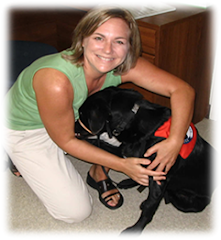
Jumpstart Therapies hosted a Pet Partners Team Training and Evaluation this weekend at Kidz Therapeze in Killeen, TX. Pet Partners, a training program of the
Delta Society, is structured to train volunteers and their pets to conduct visits in health care settings. The registration that participants receive upon completion of this course and evaluation is a 2 year national registration. Individuals who successfully complete the training are prepared to conduct visits in hospitals, schools, nursing homes, and other health care facilities that may be interested in receiving such services.
Participants this weekend attended a 2 day training course and then an evaluation in which the team (the person and dog) is assessed for skills and aptitude. Temperament, obedience, appearance,and attitude of the potential therapy animal and interactive skills, appearance, and aptitude of the person are the general areas being assessed. Teams going through the evaluation participated in a modified Canine Good Citizenship Test, in which each exercise of the test represent potential situations a visiting team may encounter while working in different settings. Tammy Renaud, of Jumpstart Therapies, has been an instructor and evaluator for the Delta Society since 1997.

Included in the exercises are basic obedience skills of "sit", "down", and "stay", as well as loose leash walking, "leave it", and taking a treat gently. Above, Joe and "Darla" are demonstrating the "stay" command while the evaluator attempts to distract the dog. Basic obedience exercises show that the dog's behavior can be redirected and the handler has good control of the animal. When a dog has good "manners" during a visiting animal session, it shows the dog has respect for others, is in control of their behavior, and the handler is aware of their animal's behavior at all times. And, we all know how much we appreciate good manners!
Here, Prima is taking her dog, "Kenya" out for a walk. This demonstrates that she has control while walking her dog on a loose leash. This is very important in visiting animal situations because you want to ensure that at all times you have leash control of your animal. A dog that is not controlled can be a potential fall or "trip" hazard to people they may encounter.

When working with people who have mobility challenges, therapy animals have to learn to accept many different types of equipment that they may encounter in health care settings. Most commonly, this includes equipment like wheelchairs, walkers, canes, and crutches. It also includes other things that they may be in and around in hospitals, such as IV poles, hospital beds, and other medical equipment. Other visual distractions include such things as flowing hospital gowns, lines from the IV poles, and anything in the environment that may cause potential stress in the visiting animal. We assess how a dog tolerates these visual (and auditory) distractions so that we can predict how the animal may react in a real-life situation. In the scenario below, Kathy (in the gown) and Jennifer (using the walker) are having an argument as Jenna and dog, Schooner, approach. It is not uncommon to be around people who are emotional, which is the purpose of this scenario. Note the dog's interest in the hospital equipment. He is obviously curious, but does not seem to be bothered by the angry yelling going on around him or by the visual distractions. Instead, he is engaging in interaction with Jennifer and is guided through this potentially stressful situation by his handler, Jenna.

We also assess how the animals respond to groups of people petting them. It is not at all uncommon to be crowded during a visiting situation, especially when first arriving on the scene. So many people are interested in seeing the animal and rush over to say "hi". This is not at all uncommon when working with children. We want to ensure that the animals are "okay" with having so many people around them. This scenario shows how much these dogs love people. As you can see, Darla is eating the attention UP!!

Appearance and grooming is very important to maintaining health standards for therapy animals. Through proper preparation the handler is ensuring that their dog is in 100% health and that all precautions are taken to make sure that their dog has not introduced any zoonotic diseases to the people they visit. Prior to the evaluation and subsequent visits to health care settings, the handler is responsible for bathing their animal, checking their teeth for cleanliness, and trimming/filing nails. In this photo, "Meeko" is being evaluated on his overall grooming and appearance. He has sparkly white teeth!!!

One test not included in the overall evaluation but definitely necessary....how many pounds of Great Dane can a volunteer hold in her lap at one time???

Jumpstart Therapies would like to welcome the 11 new Pet Partner teams to the Delta Society family. Congratulations to each and every one of you!! We truly hope that you enjoy doing this work as much as we do.
Additionally, we would like to welcome our two newest teams to our facility at KidzTherapeze. Congratulations to Kathy Warren, SLP-CCC and her dog "Abby" (photo to come) and to Dr. Isabel Cantu, PT and her dog "Oscar"--photo below. We welcome these two therapists and their 4 legged therapy team mates to our ever-growing AAT program. Congrats to you all!!!

For more information about Pet Partners and upcoming Pet Partners events, go to the
Jumpstart Therapies home page and go to the "About Us" section. We have an events calendar with listings of upcoming events. Or you can find events in your area on the
Delta Society webpage.
Our next Pet Partners event in Killeen, TX will be April 11, 12, and 13th. Evaluations will be open to renewing Pet Partner teams if space is available.






























